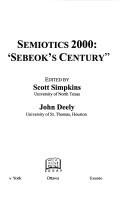| Listing 1 - 10 of 1223 | << page >> |
Sort by
|
Book
ISBN: 9782746221376 Year: 2008 Publisher: Paris : Hermes Science Publications ; Lavoisier,
Abstract | Keywords | Export | Availability | Bookmark
 Loading...
Loading...Choose an application
- Reference Manager
- EndNote
- RefWorks (Direct export to RefWorks)
La sémiotique a connu, naguère, un succès quasiment hégémonique. Elle est parfois stigmatisée, aujourd'hui, au nom d'une même incompréhension sur sa valeur et sur son projet. Le tournant sémiotique décrit cette discipline comme une aventure intellectuelle confrontée aux objets, aux processus, au conflit, à l'incertitude. Il examine, méthodiquement, les questions théoriques posées par le projet de dire " quelque chose de sensé sur le sens ".Ce livre exigeant mais d'une grande clarté, empruntant ses exemples à l'art, à la vie quotidienne, à la politique, offre à ceux qui connaissent mal la sémiotique, l'occasion de voir en elle une aventure de pensée, plutôt qu'une collection de recettes. A ceux qui la pratiquent déjà, en sciences du langage, dans les disciplines esthétiques, en sciences de l'information et de la communication, dans les divers domaines professionnels, cet ouvrage impose un retour aux questions les plus essentielles sur leur façon même de procéder.
Book
ISBN: 9783110616231 Year: 2021 Publisher: Berlin ; Boston : De Gruyter,
Abstract | Keywords | Export | Availability | Bookmark
 Loading...
Loading...Choose an application
- Reference Manager
- EndNote
- RefWorks (Direct export to RefWorks)
The book is an in-depth presentation of the European branch of semiotic theory, originating in the work of Ferdinand de Saussure. It has four parts: a historical introduction, the analysis of langue, narrative theory and communication theory. Part I briefly presents all the semiotic schools and their main points of reference. Although this material is accessible in many other Anglophone publications, the presentation is marked by specific choices aiming to display similarities and differences. The analysis of langue in Part II is also available in Anglophone bibliography, but the book presents Saussurean theory according to a new theoretical rationale and enriched with later developments. In addition, it is orientated so as to offer the foundation for the part that follows. Part III is a presentation of Greimasian narrative theory, well documented in Francophone bibliography but poorly represented in Anglophone publications. The presentation extends the theory in both a qualitative and a new quantitative direction, and includes a great number of examples and two extended textual analyses to help the reader understand and apply it. Part IV, communication theory, combines an extension of Greimasian sociosemiotics with other schools of thought. This original theoretical section discusses fourteen consecutive communication models, the synthesis of which results in a holistic, social semiotic theory of communication.

ISBN: 1894508254 Year: 2001 Publisher: New York, NY ; Toronto, Ont : LEGAS,
Abstract | Keywords | Export | Availability | Bookmark
 Loading...
Loading...Choose an application
- Reference Manager
- EndNote
- RefWorks (Direct export to RefWorks)
Book
ISBN: 9783110658828 Year: 2021 Publisher: Berlin ; Boston : De Gruyter,
Abstract | Keywords | Export | Availability | Bookmark
 Loading...
Loading...Choose an application
- Reference Manager
- EndNote
- RefWorks (Direct export to RefWorks)
In a world of global communication, where each one's life depends increasingly on signs, language and communication, understanding how we relate and opening ourselves to otherness, to differences in all their forms and aspects is becoming more and more relevant. Today, we often understand the differences in terms of adversity or opposition and forget the value of the similarities.Semiotic approaches can provide a critical point of view and a more general reflection that can redefine some aspects of the discussion about the nature of these semiotic categories, differences and similarities. The dichotomy differences - similarities is fundamental to understanding the meaning-making mechanisms in language (De Saussure, 1966; Deleuze, 1995), as well as in other sign systems (Ponzio, 1995; Sebeok & Danesi, 2000). Meaning always appears in the "play of differences" (Derrida, 1978) and similarities. Therefore, the phenomena of similarities and differences must be considered complementary (Marcus, 2011).This book addresses and offers new perspectives for analyzing and understanding sensitive topics in the world of global communication (humanities education, responsive understanding of otherness, digital culture and new media power).
Book
Year: 1969 Publisher: Paris : Éditions du Seuil,
Abstract | Keywords | Export | Availability | Bookmark
 Loading...
Loading...Choose an application
- Reference Manager
- EndNote
- RefWorks (Direct export to RefWorks)
Book

ISBN: 9782359351880 Year: 2017 Publisher: Limoges : Lambert Lucas,
Abstract | Keywords | Export | Availability | Bookmark
 Loading...
Loading...Choose an application
- Reference Manager
- EndNote
- RefWorks (Direct export to RefWorks)
Book
ISBN: 351811171X Year: 1983 Publisher: Frankfurt am Main : Suhrkamp,
Abstract | Keywords | Export | Availability | Bookmark
 Loading...
Loading...Choose an application
- Reference Manager
- EndNote
- RefWorks (Direct export to RefWorks)
Book
ISBN: 9736112799 Year: 2004 Publisher: Iasi Institutul european
Abstract | Keywords | Export | Availability | Bookmark
 Loading...
Loading...Choose an application
- Reference Manager
- EndNote
- RefWorks (Direct export to RefWorks)
Book
Year: 1978 Publisher: Toulouse : Privat,
Abstract | Keywords | Export | Availability | Bookmark
 Loading...
Loading...Choose an application
- Reference Manager
- EndNote
- RefWorks (Direct export to RefWorks)
Semiotique --- Semiotique
Book
Year: 1971 Publisher: Paris : PUF - Presses Universitaires de France,
Abstract | Keywords | Export | Availability | Bookmark
 Loading...
Loading...Choose an application
- Reference Manager
- EndNote
- RefWorks (Direct export to RefWorks)
Semiotique --- Semiotique
| Listing 1 - 10 of 1223 | << page >> |
Sort by
|

 Search
Search Feedback
Feedback About UniCat
About UniCat  Help
Help News
News